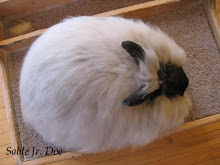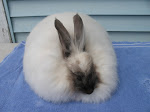Another previously published post:
I have 3 new litters this week----2 all REW litters out of Chartres and Calista sired by Marcel, and 1 litter of 2 (originally 3) out of Edelweiss, who had 1 REW and 2 Chestnuts by Emil. Anja, my Black doe, lost a litter of 9 the other day when she kindled overnight and failed to pull any wool (this was her first litter and by the time she pulled a pile the next day it was much too late:( ). I've already repeated her breeding and also gone ahead and fostered Edelweiss' babies over to Chartres since Chartres had only 4 this time and needs litters of 6-8 considering the amount of milk she produces. When I pulled the box out this morning all 6 of her babies were filled to bursting, so I may foster a few more over from Calista if it seems like she could use the break over the next couple of days, LOL.
There are several kit behaviors I have noticed over the years that make it easy to tell whether a litter has been fed well or not. I am normally one of those breeders who takes all nestboxes indoors and only brings them out for a feeding until the babies are 3 weeks old, but there are times when I have a doe who does not jump into the box right away and takes her time getting around to feeding. In those situations I need to leave it out longer and check babies periodically to tell whether they have been fed and the box can be brought back in:).
The reason I bring my boxes back and forth is two (or three) fold. First of all, I like to be present when feedings are taking place to avoid kits dying of exposure after being dragged out of the nest. With some does this hardly ever happens but with others I am almost guaranteed to find one or two on the wire after every feeding, so I always hang around to put everyone back in. Second, since we live near the woods in a very rural setting, the chance of predators invading the barn at night to snatch babies is a very real possibility, so I avoid that by having everyone safe in the house after dark. Thirdly, I don't like to take chances that baby feet will get caught in the floor wire, so lately I have kept litters in the house in hay padded carrying cages or rubbermaid tubs until 3 weeks of age, when their feet are usually big enough to be safe and they are ready to eat solid food and live with Mom in the cages full time. Keeping litters indoors also allows me to keep closer tabs on the babies, and they are handled more often by people as a result.
Babies who have just been fed will typically be very fat, and they are often wet with urine (which usually happens right after feeding). Right after they have eaten and the doe leaves the nest they begin digging away at the nesting material in an effort to fluff up the wool and dry the nest. This is when you hear frantic scratching noises (from older babies, especially), after which the entire litter settles into a pile and goes to sleep. Well fed babies are dopey and sluggish in much the way human babies (newborns) are right after they have nursed or finished a bottle.
Babies who have NOT been fed have thin and wrinkled stomachs, and when you stick your hand into the nest they immediately begin squirming, squealing, and "popping" up in an effort to find food (remember that newborn kits are blind and locate food by warmth and smell). If I have not looked at anyone's stomachs but the babies are jumping left and right when I stick my hand in, it is a pretty fair guess that they have not been fed.
Sometimes you will have a litter that has not been fed very much, (or enough to fill their bellies completely), and they will still be active after a feeding. Situations like this typically resolve themselves about 2-3 days after birth when the doe's real milk comes in and a regular nursing pattern gets established, but if you find that the litter is not quite full you can bring the box back to the doe again later in the day. Sometimes this works and sometimes it doesn't, but either way the baby/s should catch up quickly over the next day or two.
Occasionally you WILL get a doe who never gets milk due to genetics, sickness, or poor mothering ability (which is usually genetic as well). In a case like this you have no choice but to foster the litter to another doe who has been bred to kindle at the same time. If the doe in question is a first timer you may want to breed her again to see if the problem reasserts itself, but if you have tried 3 or more times with the same result, cull her out and think twice about keeping any of the babies she produced. It is a good idea ALWAYS to breed 3-4 does at a time because you will need extra mothers to foster babies to in the event of an emergency, and if you only breed 2 there is the chance that one of them won't take. Fostering is a very simple procedure that requires no paraphenalia----just take the babies out of one nest and place them into the pile of babies in the other nest several hours before bringing them to the doe. By feeding time they will all smell exactly the same and she will never know the difference. It is the simplest solution for orphaned babies:). If you need to foster babies of the same color together (REW, for example), take a black Sharpie and mark the inside of one or both ears for identification, redrawing them every day or two to keep things clear and legible until weaning.
Once the first 5-6 days after birth have passed, everything seems to fall into line and nursing becomes a regular task that the moms take care of casually and expertly. At the age of 3 weeks babies are out of the nest, beginning to eat, and displaying signs of normal rabbit behavior. Mom lays off to the side and patiently allows the little ones to climb and sleep all over her, nursing as needed until they are ready to wean.
Back to the here and now, there were three new litters born last week out of Pascha/Pierre (1 REW and 1 Sable), Neva/Dijon (2 Torts, 3 REWs), and Echo/Pierre (4 Sables, 4 Pearls, 5 REWs). All are doing very well except for two or three in Echo's litter, who I wouldn't be surprised to lose considering the size of the overall bunch. Work is over for the summer so I will be getting back to a normal blog schedule now starting Wednesday. It should be a productive summer what with the breedings going on and working to renovate my website (long, long past due, LOL). It will all be lots of fun and hopefully result in lots of fabulous babies, which is always a good thing:).
Best of luck getting those girls bred, and have a wonderful week!:^)
Sunday, June 22, 2008
Subscribe to:
Post Comments (Atom)























No comments:
Post a Comment